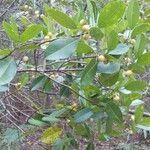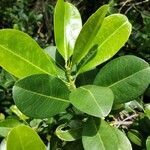A tall shrub. It grows 3-10 m tall and spreads 2-5 m across. It has a dark green crown. The young shoots are reddish. The leaves only have one leaflet. They are 5-12 cm long by 1.5-5 cm across. They are shaped like an ellipse. The leaf is notched at the tip. They are dark green on top and paler underneath. The oil dots are very small and scarcely visible. The leaf stalk is 0.5-2.5 cm long. Flowers occur in a branched stalk in the axils of leaves. Only a few flowers occur and they are about 1 cm across. Flowers are yellow. The fruit is fleshy and 1-2 cm long. It is oval in shape and yellow or orange. The fruit is edible.



